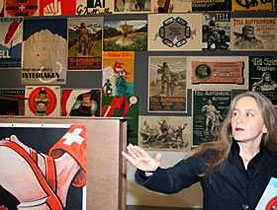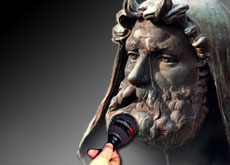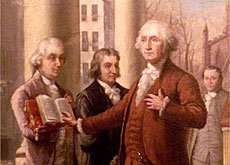Posters Tell the message of Swiss hero

William Tell has unwittingly been advertising on posters from the moment the medium was invented – with or without crossbow, son or apple pierced with an arrow.
The Swiss National Library is currently showing some 100 posters at an exhibition in Bern that reveals just how Tell has been doing public relations work for shooting festivals, political parties, voting campaigns, films and products.
Nothing can bring across a message that is as Swiss, to the point and self evident as a crossbow, a hat belonging to the much-despised Gessler or an apple that’s been shot through by an arrow.
Anyone who goes to school in Switzerland knows the particular attributes of William Tell, the Swiss national hero who made his name in Friedrich Schiller’s play of the same name.
So it should come as no surprise that the worlds of politics and advertising have made use of the Tell myth.
Message
The exhibition “Tell in Focus” displays a selection of posters on which the hero of the nation tries to convey a particular message.
The poster as a mass medium is said to have contributed in no small way to Tell being fixed in the mind of the Swiss as the personification of freedom.
Tell first appeared to the Swiss as an urban, stately and aristocratic person on a poster in Geneva in 1887. His pose was that of someone self-assured and at the height of his triumph, writes Mechthild Heuser, joint-author of a book that accompanies the exhibition called “Tell in Focus”.
However, this urbane version of Tell did not make it onto the poster hoardings located across the country.
“Of all the Tell portrayals, the one that is the most significant is Richard Kissling’s bronze statue of 1895 that stands in Altdorf,” Heuser says.
Humble herdsman
It was to be Altdorf’s “countrified, eternally roving… humble alpine herdsman, who would look down on Swiss citizens from poster hoardings and still does today”.
Many posters have used this version of Tell as their inspiration. Even the Swiss five-franc coin and earlier postage stamps can trace their roots back to the Altdorf original.
“But the Tell of the renowned Swiss painter Ferdinand Hodler, which appeared two years after Kissling’s statue, has hardly ever been used by poster artists,” Heuser says.
She suspects that the Hodler version was too gladiator-like, too irate and polarising to be used as a myth.
It was Kissling’s “peace-loving, innocent family father walking down the mountain with his arm around his son” that won the day on the poster.
Blue jeans
This Tell has no airs about him and was more suited than Hodler’s version to wearing a pair of perfectly fitting blue jeans – as he did in a controversial Levi’s advertisement in the early 1970s.
Such cult pictures tend to portray a kind of alienation and irony. Political campaigns of every shade of colour have used this aspect for many years.
For example, the Rütli oath when representatives of Schwyz, Uri and Unterwalden are said to have sworn a pact of mutual support in 1291, was used by the Social Democrats in 1935 as a theme to promote equality between men and women.
And on the most recent occasion in June this year the rightwing Swiss People’s Party used irony and alienation when it fought against the liberalisation of drugs in the French-speaking part of Switzerland.
It swapped the crossbow on Tell’s neck for a larger-than-life syringe.
swissinfo, Alexander Künzle
The exhibition of posters featuring William Tell is on at the Swiss National Library in Bern until the end of March 2008.
The posters are from the library’s graphic collection.
A book – Tell in Focus – has been compiled by Mechthild Heuser and Irmgard M. Wirtz.
Memoriav, the organisation that preserves and indexes Switzerland’s audiovisual cultural heritage, supported the creation of general catalogue of Swiss posters from 1999 to 2006.
Under the guidance of the national library, about 34,000 posters from various collections have been digitalised, catalogued and integrated into the Swiss Poster Collection data bank.
The conservation of original posters has also been improved.
The collection is available online.

In compliance with the JTI standards
More: SWI swissinfo.ch certified by the Journalism Trust Initiative












You can find an overview of ongoing debates with our journalists here . Please join us!
If you want to start a conversation about a topic raised in this article or want to report factual errors, email us at english@swissinfo.ch.